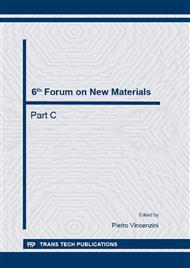p.23
p.27
p.32
p.38
p.44
p.50
p.56
p.66
p.72
Energy Gap Associated to Photocatalytic Activity of MWCNT/TiO2/ZnO Nanocomposites
Abstract:
Carbon nanotubes (CNT) have been investigated for a wide range of applications. The combination of the CNT structure with semiconductors oxides opens up various application possibilities: water separation for hydrogen generation, degradation of pollutants in aqueous contamination and sewage treatment, photoreduction of CO2 activity in self-cleaning air purification and dyes for solar cells. The junction multi-walled carbon nanotubes with dioxide titanium and zinc oxide (MWCNT-TiO2-ZnO), when used as support, can facilitate a change in electron transfer, increasing the photocatalytic activity. MWCNTs/TiO2/ZnO nanocomposites were prepared by the modified sol-gel method using MWCNTs, titanium (IV) propoxide, commercial TiO2 (P25) as titanium sources, zinc oxide produced in the laboratory by thermal evaporation and commercial ZnO. The composites obtained from the titanium (IV) propoxide were prepared by solution processing followed by thermal treatment at 500° C. The results were associated with the characteristics of the nanocomposites using Raman spectroscopy. The photocatalytic activity on organic dye was associated to energy gap evaluated by diffuse reflectance spectroscopy.
Info:
Periodical:
Pages:
44-49
Citation:
Online since:
October 2014
Price:
Сopyright:
© 2014 Trans Tech Publications Ltd. All Rights Reserved
Share:
Citation:


